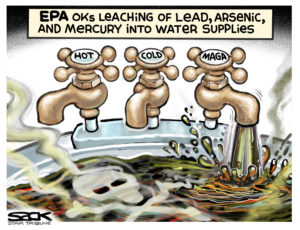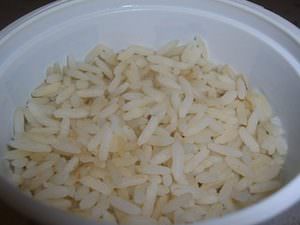11,000 Scientists Warn We’re Headed Toward ‘Untold Suffering’
Experts from 153 nations unite to issue a stark warning about the climate emergency. A message from Germany as the climate emergency intensifies. (Markus Spiske / Unsplash)
A message from Germany as the climate emergency intensifies. (Markus Spiske / Unsplash)
In an unprecedented step, more than 11,000 scientists from 153 nations have united to warn the world that, without deep and lasting change, the climate emergency promises humankind unavoidable “untold suffering.”
And as if to underline that message, a US research group has predicted that – on the basis of experiments so far – global heating could reduce rice yields by 40% by the end of the century, and at the same time intensify levels of arsenic in the cereal that provides the staple food for almost half the planet.
And in the same few days a second US group has forecast that changes to the world’s vegetation in an atmosphere increasingly rich in carbon dioxide could mean that – even though rainfall might increase – there could be less fresh water on tap for many of the peoples of Europe, Asia and North America.
Warnings of climate hazard that could threaten political stability and precipitate mass starvation are not new: individuals, research groups, academies and intergovernmental agencies have been making the same point, and with increasing urgency, for more than two decades.
New analysis
The only argument has been about in what form, how badly, and just when the emergency will take its greatest toll.
But the 11,000 signatories to the statement in the journal BioScience report that their conclusions are based on the new analysis of 40 years of data covering energy use, surface temperature, population growth, land clearance, deforestation, polar ice melt, fertility rates, gross domestic product and carbon emissions.
The scientists list six steps that the world’s nations could take to avert the coming catastrophe: abandon fossil fuel use, reduce atmospheric pollution, restore natural ecosystems, shift from animal-based to plant diets, contain economic growth and the pursuit of affluence, and stabilise the human population.
Their warning appeared on the 40th anniversary of the first world climate congress, in Geneva in 1979.
Surprising rice impact
“Despite 40 years of major global negotiations, we have continued to conduct business as usual and have failed to address this crisis,” said William Ripple of Oregon State University, one of the leaders of the coalition. “Climate change has arrived and is accelerating faster than many scientists expected.”
Both the warning of catastrophic climate change and the steps to avoid it are familiar. But researchers at Stanford University in the US say they really did not expect the impact of world temperature rise on the rice crop – the staple for two billion people now, and perhaps 5 bn by 2100 – to be so severe.
Other groups have already warned that changes in seasonal temperature and rainfall could reduce both the yields of wheat, fruit and vegetables, and the nutritional values of rice and other staples.
The Stanford group report in the journal Nature Communications that they looked more closely at what climate change could do to rice crops. Most soils contain some arsenic. Rice is grown in flooded paddy fields that tend to loosen the poison from the soil particles. But higher temperatures combined with more intense rainfall show that, in experiments, rice plants absorb more arsenic, which in turn inhibits nutrient absorption and reduces plant development. Not only did the grains contain twice the level of arsenic, the yield fell by two-fifths.
“We have continued to conduct business as usual and have failed to address this crisis. Climate change has arrived and is accelerating faster than many scientists expected”
“By the time we get to 2100, we’re estimated to have approximately 10bn people, so that would mean we have 5 billion people dependent on rice, and 2bn who would not have access to the calories they would normally need,” said Scott Fendorf, an earth system scientist at Stanford.
“I didn’t expect the magnitude of impact on rice yield we observed. What I missed was how much the soil biogeochemistry would respond to increased temperature, how that would amplify plant-available arsenic and then – coupled with temperature stress – how that would really impact the plant.”
And while the rice croplands expect heavier rains, great tracts of the northern hemisphere could see vegetation changes that could have paradoxical consequences. In a wetter, warmer world plants could grow more vigorously. The stomata on the leaves through which plants breathe are more likely to close in a world of higher levels of atmospheric carbon dioxide, meaning less water loss through foliage.
And while this should mean more run-off and a moister tropical world, a team at Dartmouth College in the US report in the journal Nature Geoscience that in the mid-latitudes plant response to climate change could actually make the land drier instead of wetter.
Water consumption rises
“Approximately 60% of the global water flux from the land to the atmosphere goes through plants, called transpiration. Plants are like the atmosphere’s straw, dominating how water flows from the land to the atmosphere. So vegetation is a massive determinant of what water is left on land for people,” said Justin Mankin, a geographer at Dartmouth.
“The question we’re asking here is, how do the combined effects of carbon dioxide and warming change the size of that straw?”
The calculations are complex. First, as temperatures soar, so will evaporation: more humidity means more rain – in some places. As atmospheric carbon dioxide levels soar, driven by fossil fuel combustion, plants need less water to photosynthesise, so the land gets more water. As the planet warms, growing seasons become extended and warmer, so plants grow for a longer period and consume more water, and will grow more vigorously because of the fertility effect of higher carbon dioxide concentrations.
The calculations suggest that forests, grasslands and other ecosystems will consume more water for longer periods, thus drying the soil and reducing ground water, and the run-off to the rivers, in parts of Europe, Asia and the US.
Avoiding the worst
And that in turn would mean lower levels of water available for human consumption, agriculture, hydropower and industry.
Both studies are indicators of possible hazard, to be confirmed or challenged by other scientific groups. But both exemplify the complexity of the challenge presented by temperature rises of at least the 2°C set by 195 nations in Paris in 2015 as the limit by the century’s end; or the 3°C that seems increasingly likely as those same nations fail to take the drastic action prescribed.
The world has already warmed by almost 1°C above the long-term average for most of human history. So both papers shore up the reasoning of the 11,000 signatories to the latest warning of planetary disaster. But that same warning contains some steps humankind could take to avert the worst.
“While things are bad, all is not hopeless,” said Thomas Newsome, of the University of Sydney, Australia, and one of the signatories. “We can take steps to address the climate emergency.”
Your support matters…Independent journalism is under threat and overshadowed by heavily funded mainstream media.
You can help level the playing field. Become a member.
Your tax-deductible contribution keeps us digging beneath the headlines to give you thought-provoking, investigative reporting and analysis that unearths what's really happening- without compromise.
Give today to support our courageous, independent journalists.







You need to be a supporter to comment.
There are currently no responses to this article.
Be the first to respond.